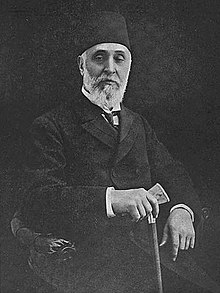
Back سردار Arabic সরদার (পদবি) Bengali/Bangla Serdar BS Sardar Catalan Sardar German Sardar Spanish سردار (عنوان) Persian Sardar French सरदार Hindi Սարդար Armenian
This article needs additional citations for verification. (November 2020) |




Sardar, also spelled as Sardaar (Persian: سردار, Persian pronunciation: [særˈdɑr], 'commander', literally 'headmaster'), is a title of royalty and nobility that was originally used to denote princes, noblemen, chiefs, kings and other aristocrats. It has also been used to denote a chief or leader of a tribe or group. It is used as a Persian synonym of the title Emir of Arabic origin.
The term and its cognates originate from Persian sardār (سردار) and have been historically used across Persia (Iran), the Ottoman Empire and Turkey (as "Serdar"), Afghanistan (as "Sardar" for a member of the royal Mohammadzai clan in meaning of noblemen), Mesopotamia (now Iraq), Syria, South Asia (Pakistan, India, Bangladesh and Nepal), the Caucasus, Central Asia, the Balkans and Egypt (as "Sirdar").[2]
Amongst Sikhs, the term began to be adopted due to Afghan influence in the mid-18th century to signify a leader of a Jatha or Misl and gradually replaced other prior used terms for these positions, such as 'Jathedar' and 'Misldar'.[3] The term sardar was used by Sikh leaders and generals who held important positions in various Sikh Misls. The title is still commonly used by Sikhs today. Though historically signifying one's military rank or membership of a locally important family, in the contemporary period the title is used widely in India and neighbouring countries for any respected Sikh male. Sardar was also used to refer to generals of the Maratha Empire. After the decline of feudalism, sardar later indicated a Head of State, a Commander-in-chief, and an army military rank. As a military rank, a sardar typically marked the Commander-in-Chief or the highest-ranking military officer in an army, akin to the modern Field Marshal, General of the Army or Chief of Army. The more administrative title Sirdar-Bahadur denoted a Governor-General or Chief Minister of a remote province, akin to a British Viceroy.
In Himalayan mountaineering, a sirdar is a local leader of the Sherpas.[4] Among other duties, he records the heights reached by each Sherpa, which factors into their compensation.
- ^ "Jackie Kennedy receives horse from governor of Pakistan – Mar 23, 1962 – HISTORY.com". history.com. Archived from the original on 2016-03-17.
- ^ Chisholm, Hugh, ed. (1911). . Encyclopædia Britannica. Vol. 25 (11th ed.). Cambridge University Press. p. 154.
- ^ Singh, Harbans. The Encyclopedia of Sikhism. Vol. 2: E-L. Punjabi University, Patiala. pp. 362–3.
- ^ Sayre, Woodrow Wilson (1964). Four Against Everest. Englewood Cliffs, NJ, USA: Prentice-Hall. Library of Congress Catalog Card No: 64-15208 223.